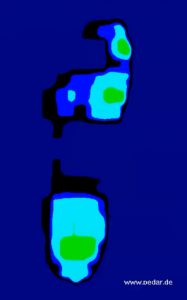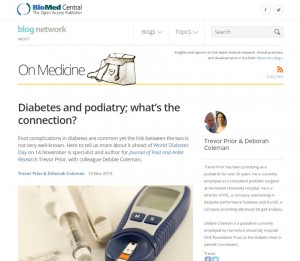- March 2016 (1)
- November 2015 (1)
- February 2015 (1)
- January 2015 (1)
- July 2014 (2)
- June 2014 (1)
- May 2014 (1)
- April 2014 (2)
The use of orthoses (insoles) for managing pain in the big toe (1st MTPJ)
A 70 year old male was referred with osteoarthrosis of the left big toe joint (1st MTPJ). This had been present for approximately 5 years and had only partially responded to injections and insoles (orthoses).
Clinical examination indicated bony thickening on the left consistent with the osteoarthrosis but dorsiflexion was only mildly limited at 600 with a similar range of motion on the right.
A biomechanical evaluation revealed a small leg length discrepancy with the shorter right side having a slightly earlier heel lift.
Inshoe pressure analysis revealed that there was earlier loading on the inside of the left forefoot with the big toe (Hallux) loading a little earlier than the ball of the foot as is common with this type of problem. However, towards the end of the step, the weight transfers towards the outside of the foot due to limited motion in the big toe joint.
It was felt that the slightly longer leg was causing the increased load on the inside of the foot and this was causing more jamming of the big toe joint and, as a result, when the end of motion was reached, the load was transferred to the outside of the foot. By contrast, the load remains through the big toe joint / toe on the right side.
The patient had been provided with a pair of insoles previously which had helped to an extent. However, on more detailed evaluation, it was clear these were helping by effectively splinting the toe and preventing the big toe joint from moving.
This can be seen in the video below which clearly shows the big toe loading early and the load remaining along the outside (lateral) aspect of the foot.
As the examination had revealed relatively symmetrical underlying structure and the longer left leg could contribute to the increased load on the left, it was felt that better function and thus symptom relief could be achieved. Orthoses were therefore provided and adapted using the inshoe pressure analysis to achieve a much more normal loading pattern as demonstrated in the video below. This was successful in reducing symptoms.
Have a look at our blog for World Diabetes day
In conjunction with my colleague Debbie Coleman, we have written a short blog about Diabetes and Podiatry for Biomed Central as to-day is World Diabetes Day. Click the photo to go to the blog:
Medial tibial Stress Syndrome
Medial Tibial Stress syndrome is a common running injury, which is often mistermed as shin splints; a generic term for leg pain during exercise. It is important to get the correct diagnoses to get the right treatment.
One of our Podiatrists Nick Knight has written a blog about Medial Tibial Stress Syndrome covering:-
- What is Medial Tibial Stress Syndrome
- How does Medial Tibial Stress Syndrome present
- What are the risk factors for Medial Tibial Stress Syndrome
- How to treat Medial Tibial Stress Syndrome, with some take home tips that you can start using at home.
The blog can be found here: Medial Tibial Stress Syndrome by Nick Knight
Click here for our guide

 Call 020 8502 1777 or
Call 020 8502 1777 or  online form
online form
